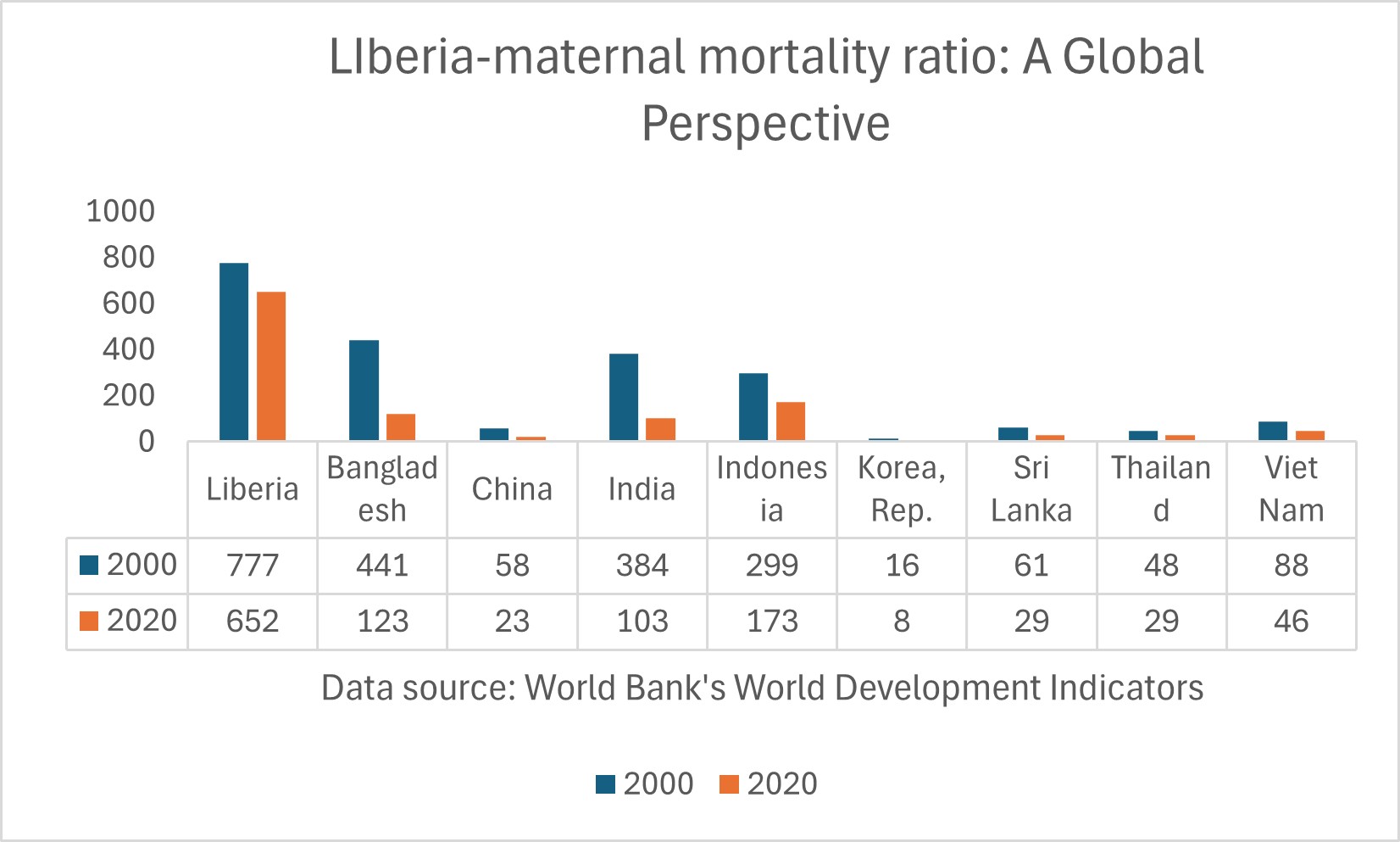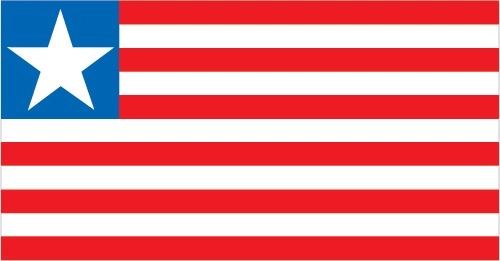
Liberia
Country Flag Details 11 equal horizontal stripes of red (top and bottom) alternating with white; a white five-pointed star appears on a blue square in the upper hoist-side corner; the stripes symbolize the signatories of the Liberian Declaration of Independence; the blue square represents the African mainland, and the star represents the freedom granted to the ex-slaves; according to the constitution, the blue color signifies liberty, justice, and fidelity, the white color purity, cleanliness, and guilelessness, and the red color steadfastness, valor, and fervor
note: the design is based on the US flag
Background Freed slaves from the US began being
settled in what is today Liberia in 1822. By
1847, the Americo-Liberians were able to
establish a republic. A military coup in 1980 ushered in a decade of authoritarian rule followed by a civil war. A 2003 peace
agreement ended the war, and elections
were held in 2005.
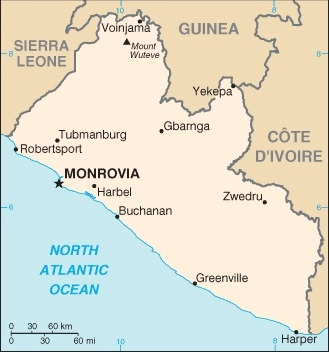
Geography
Area
total : 111,369 sq km
land: 96,320 sq km
water: 15,049 sq km
Climate
tropical; hot, humid; dry winters with hot days and cool to cold nights; wet, cloudy summer swith frequent heavy showers
Natural resources
iron ore, timber, diamonds, gold, hydropower
People and Society
Population
total: 5,437,249
Ethnic groups
Kpelle 20.2%, Bassa 13.6%, Grebo 9.9%,
Gio 7.9%, Mano 7.2%, Kru 5.5%, Lorma
4.8%, Krahn 4.5%, Kissi, 4.3%, Mandingo
4.2%, Vai 3.8%, Gola 3.8%, Gbandi 2.9%,
Mende 1.7%, Sapo 1%, Belle 0.7%, Dey
0.3%, other Liberian ethnic group 0.4%,
other African 3%, non-African 0.2% (2022
est.)
Languages English 20% (official) and 27 indigenous
languages, including Liberian English
variants
Religions
Christian 84.9%, Muslim 12%, Traditional
0.5%, other 0.1%, none 2.6% (2022 est.)
Population growth rate
2.32% (2024 est.)
Government type
presidential republic
Capital name: Monrovia
Executive branch
chief of state: President Joseph BOAKAI
(since 22 January 2024)
head of government: President Joseph
BOAKAI (since 22 January 2024)
Economy
Real GDP (purchasing power parity)
$8.882 billion (2023 est.)
$8.484 billion (2022 est.)
$8.095 billion (2021 est.)
Real GDP per capita
$1,600 (2023 est.)
$1,600 (2022 est.)
$1,500 (2021 est.)
Exports
$1.22 billion (2022 est.)
$1.041 billion (2021 est.)
$731.658 million (2020 est.)
Exports – partners
Switzerland 30%, UK 13%, France 8%,
Germany 7%, Lebanon 4% (2023)
Exports – commodities
gold, ships, iron ore, rubber, refined
petroleum (2023)
Imports
$1.961 billion (2022 est.)
$1.739 billion (2021 est.)
$1.371 billion (2020 est.)
Imports – partners
China 48%, Japan 21%, Germany 8%, Brazil 3%, Cote d’Ivoire 3% (2023)
Imports – commodities
ships, refined petroleum, rice, trucks,
centrifuges (2023)

Export structure by product groups in 2023 (% of total export) (UNCTAD)
The export structure of a country encompasses the variety, composition, and value of its goods and services traded internationally, providing vital insights into the nation’s economic health, competitiveness, and level of development. In the case of Liberia, the export structure is notably defined by its dependence on a limited range of key commodities, primarily sourced from the mining and agricultural sectors. The Liberian economy relies heavily on these commodity exports, with gold, iron ore, and rubber emerging as the principal products driving trade and revenue. Despite the substantial income generated from these exports, this narrow focus on a few commodities makes the economy vulnerable to the volatility of global price changes. In response to these challenges, there are ongoing efforts to diversify exports by investing in the development of sectors such as palm oil and cocoa, which are aimed at establishing a more robust and resilient economic foundation for Liberia’s future growth.
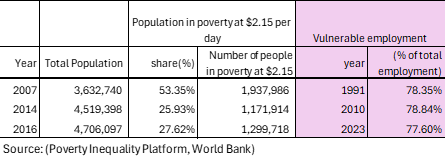
Poverty and vulnerable employment in Liberia (World Bank)
Undertstanding poverty level at $ 2.15
In 2016, 28 percent of Liberia’s population lived in poverty at $2.15 per day. The poverty level at $2.15 per day (measured in 2017 purchasing power parity, or PPP) is a key global benchmark used by the World Bank to define extreme poverty in low-income countries. It indicates:
1. Basic Survival Threshold
• People below $2.15 per day struggle to afford necessities such as food, clean water, shelter, healthcare, and education.
2. Economic Underdevelopment
• A high percentage of a country’s population living below this threshold suggests low economic productivity, high unemployment, and weak social safety nets.
3. Inequality and Social Vulnerability
• It reflects deep income inequality and a lack of access to opportunities for upward mobility.
• People in this category are more vulnerable to shocks like food price increases, climate disasters, or health crises.
4. Policy Challenges
• Governments need targeted interventions such as social welfare programs, job creation, and improved access to education and healthcare to reduce poverty.
A country's export structure is a reflection of its level of development and productive capacities
The export structure of a country refers to the composition, diversity, and value of the goods and services it sells to other countries. It provides key insights into the country’s economic health, competitiveness, and level of development. Productive capacities of a country refer to its ability to produce goods and services efficiently and sustainably over time. These capacities are shaped by various factors, including human capital, natural resources, infrastructure, private sector, development, technology & innovation, institutions & governance, financial systems trade & market access.
Here’s what the export structure and productive capacities of a country typically indicate:
- Level of Economic Development
- Developed economies usually export high-value manufactured goods, technology, and services.
- Developing economies often rely on raw materials, agricultural products, or low-value manufactured goods.
- Industrial and Sectoral Strengths
- A strong presence of high-tech or industrial goods (e.g., machinery, electronics) suggests a well-developed manufacturing sector.
- A dominance of commodities (e.g., oil, minerals, agricultural products) indicates reliance on natural resources.
- Export Diversification
- A diverse export base (multiple industries) makes a country’s economy more stable and resilient to global price shocks.
- A concentrated export base (few key products) makes it vulnerable to market fluctuations.
- Trade Partnerships and Dependence
- If exports are heavily dependent on a single country or region, the economy is more exposed to geopolitical and trade risks.
- A wide range of trading partners indicates stronger global integration.
- Competitiveness and Value Addition
- Exporting mainly raw materials (e.g., crude oil instead of refined petroleum) suggests limited industrial processing capacity.
- A high share of finished and high-tech goods suggests strong value addition and competitiveness.
Liberia-Sanitation
Liberia – Proportion of population served with at least basic sanitation
In 2022, proportion of population served with at least basic sanitation for Liberia was 22.5 %. Proportion of population served with at least basic sanitation of Liberia increased from 12.1% in 2000 to 22.5% in 2022 an absolute change of 10.4 percentage points (pp) between 2000 and 2022.
Liberia – Proportion of urban population served with at least basic sanitation
In 2022, proportion of urban population served with at least basic sanitation for Liberia was 34.3 %. Proportion of urban population served with at least basic sanitation of Liberia increased from 23.0 % in 2000 to 34.3 % in 2022 an absolute change of 11.3 pp, between 2000 and 2022.
Liberia – Proportion of rural population served with at least basic sanitation
In 2022, proportion of rural population served with at least basic sanitation for Liberia was 9.2 %. Proportion of rural population served with at least basic sanitation of Liberia increased from 3.3 % in 2000 to 9.2 % in 2022 an absolute change of 5.9 pp, between 2000 and 2022.
Liberia – Proportion of population served with at least basic sanitation: A Global Perspective
The persistent absence of safe sanitation is a critical crisis that demands our immediate attention and collective action, resulting in the loss of countless lives each year and exposing a significant public health challenge. Safe sanitation is a fundamental human right that everyone deserves. In 2022, around 4 million people, nearly 77 percent of Liberia’s population, suffered from inadequate sanitation facilities, unlike countries such as Vietnam, China, and Thailand, where only 8 percent, 5 percent, and just 1 percent faced this issue. The global average of those without sanitation access is roughly 6 percent, highlighting the urgent need for coordinated efforts to improve sanitation in underserved regions of Sub-Saharan Africa. Addressing this crisis is closely tied to health and equity, as better sanitation can provide significant benefits for education, economic stability, and the overall well-being of communities.
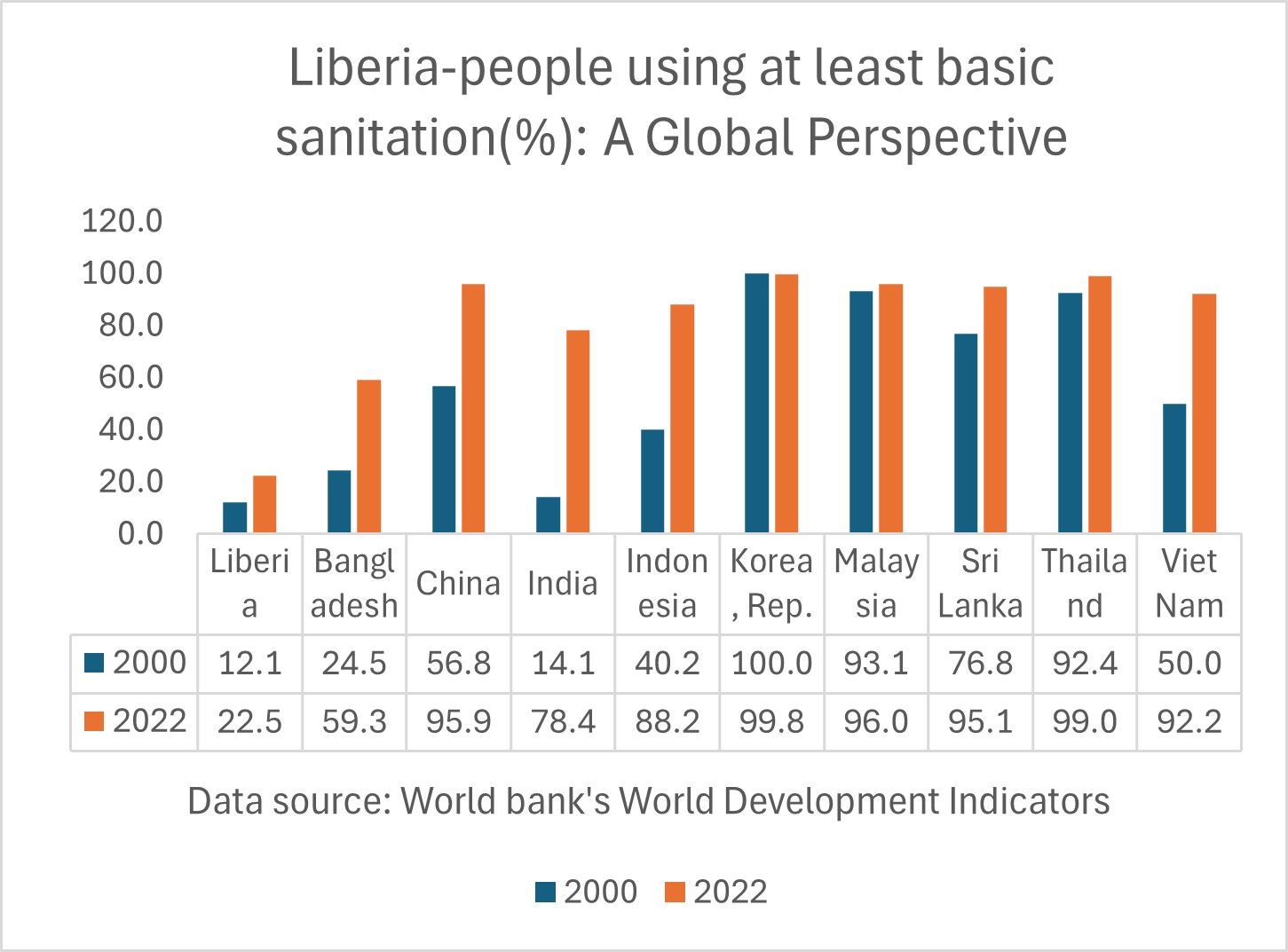
Liberia – Proportion of rural population served with at least basic sanitation: A Global perspective
In 2022, nearly 2 million people in rural Liberia, or about 91 percent of the population, lacked access to basic sanitation facilities, starkly contrasting with Vietnam, Sri Lanka, and Thailand, which reported figures of 12 percent, 5 percent, and 2 percent respectively. This lack of safe sanitation is not just a pressing issue; it represents a significant concern that requires immediate collective action, leading to the preventable deaths of many each year and highlighting a public health crisis. Safe sanitation is an essential human right that everyone deserves to access. It is crucial for us to unite in advocating for this fundamental right across Sub-Saharan Africa, where the need is greatest and the potential benefits can transform lives.

Liberia-Water Supply
Liberia – Proportion of total population served with at least basic water
In 2022, proportion of population served with at least basic water for Liberia was 75.6 %. Proportion of population served with at least basic water of Liberia increased from 62.1% in 2000 to 75.6 % in 2022 an absolute change of 10.5 pp between 2000 and 2022.
Liberia – Proportion of urban population served with at least basic water
In 2022, proportion of urban population served with at least basic water for Liberia was 84.6%. Proportion of urban population served with at least basic water of Liberia increased from 78.3 % in 2000 to 84.6 % in 2022, an absolute change of 6.3 pp between 2000 and 2022.
Liberia – Proportion of rural population with at least basic water
In 2022, proportion of rural population served with at least basic water for Liberia was 65.5%. Proportion of rural population served with at least basic water of Liberia increased from 49.2 % in 2000 to 65.5 % in 2022 an absolute percent change of 16.3 pp between 2000 and 2022.
Liberia – Proportion of total population served with at least basic drinking water: A Global Perspective
Access to safe drinking water is a fundamental right that is crucial for our health and well-being. It is alarming that in 2022, over 1 million people in Liberia, about 24 percent of the population, lacked this essential resource, highlighting a significant disparity in access to basic needs that many take for granted. In sharp contrast, everyone in Thailand had access to safe drinking water, while an impressive 98 percent of individuals in Bangladesh and Vietnam enjoyed this vital right, revealing the pronounced global inequalities. These statistics underscore the urgent need for coordinated efforts to improve living conditions and ensure equitable access to safe drinking water for vulnerable communities in Sub-Saharan Africa, where such disparities lead to health crises and broader social and economic challenges, demanding our immediate action to support those in need as we pursue a more just world.
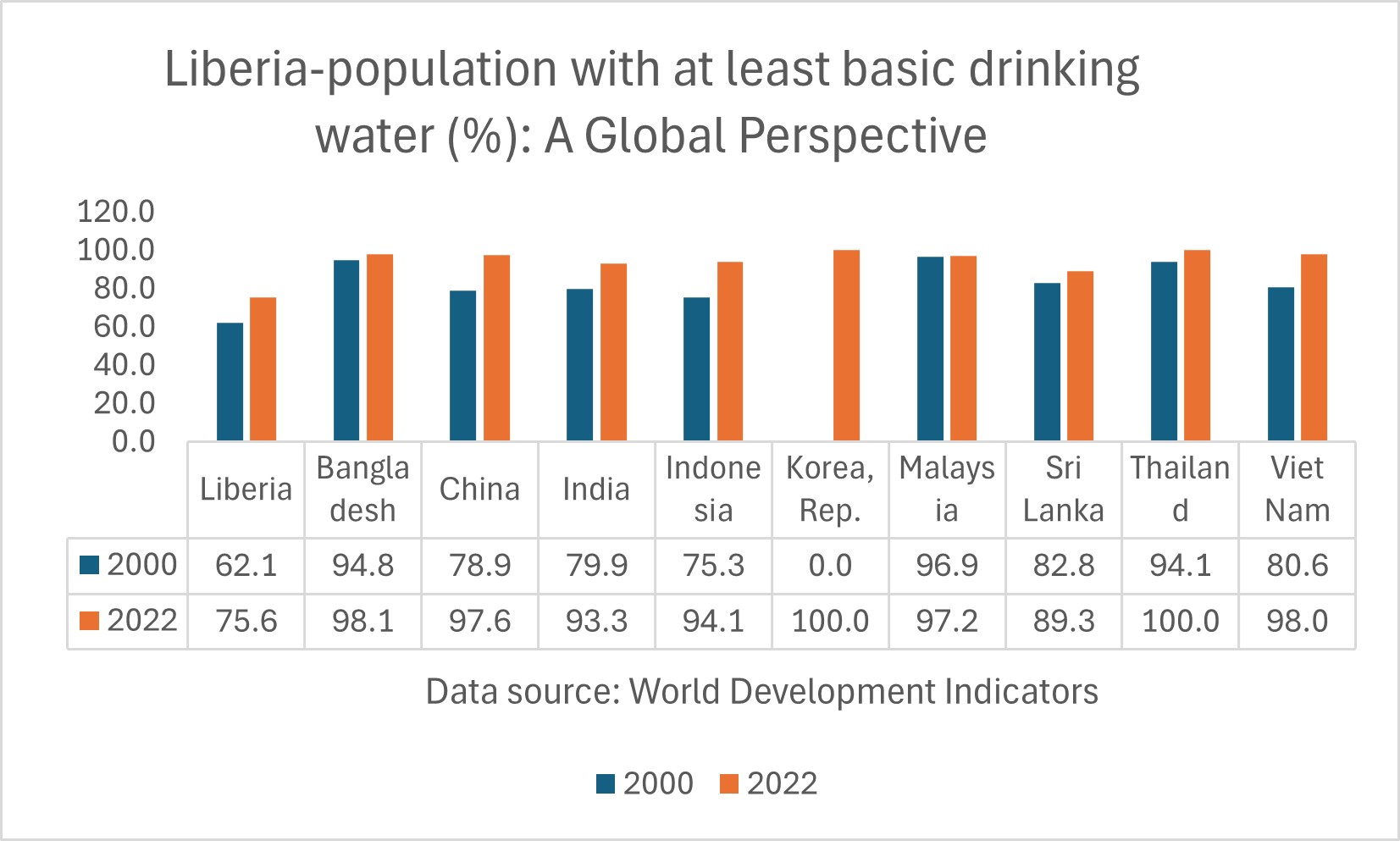
Liberia – Proportion of rural population served with at least basic drinking water: A Global Perspective
In 2022, it was deeply concerning that 34 percent of Liberia’s rural population, approximately 850 thousand individuals, lacked access to basic drinking water facilities, severely impacting their health and quality of life. This striking reality contrasts sharply with nations like Thailand and Bangladesh, where nearly all rural residents had access to safe drinking water. Such a disparity underscores the urgent need for transformative action in Sub-Saharan Africa, focusing on improving water accessibility and sustainability through innovative solutions that ensure equitable access to this vital resource, ultimately enhancing health outcomes and fostering sustainable development in affected communities.

Liberia-Access to Electricity
Liberia-Access to electricity (% of population)
In 2022, proportion of population with access to electricity for Liberia was 31.8 %. The proportion of population with access to electricity of Liberia increased from 5.3% in 2010 to 31.8% in 2022, an absolute change of 26.2 pp between 2010 and 2022.
Liberia-Access to electricity (% urban population)
In 2022, proportion of urban population with access to electricity for Liberia was 53.7%. The proportion of urban population with access to electricity of Liberia increased from 9.9% % in 2010 to 53.7% in 2022, an absolute change of 43.8 pp between 2000 and 2022.
Liberia-Access to Electricity (% rural population)
In 2022, proportion of rural population with access to electricity for Liberia was 14.9 %. The proportion of rural population with access to electricity of Liberia increased from 1 % % in 2010 to 14.9% in 2022, an absolute change of 13.9pp between 2000 and 2022.
Liberia- Share of the total population with access to electricity: A Global Perspective
In 2022, approximately 68 percent of Liberia’s population, around three and a half million people, lived without electricity, exposing a severe inequality that impacts their daily lives. This situation starkly contrasts with countries like Vietnam, Thailand, Sri Lanka, and Malaysia, where successful initiatives have achieved universal electricity access. This underscores the urgent need for comprehensive reforms in Sub-Saharan Africa to enhance living standards. Reliable electricity is a fundamental necessity that drives progress in development, health, and education, fostering economic growth and paving the way for a brighter future for all.

Liberia-Share of the rural population with access to electricity: A Global Perspective
In 2022, 85 percent of Liberia’s rural population, or about 2 million people, lived without electricity, highlighting the stark inequalities compared to countries like Vietnam, Thailand, and Sri Lanka, where every rural resident has access to this essential resource. In India and Bangladesh, 99 percent of rural communities benefit from daily electricity, underscoring the urgent need for transformative governance reforms across Sub-Saharan Africa. We must unite to ensure every community gains reliable electricity access, empowering them to realize their potential and fostering a brighter, sustainable future.

Liberia- Health outcomes
Liberia-Life expectancy: A Global Perspective
Examining life expectancy trends over the past seventy years shows that while significant advancements have led to longer and healthier lives, profound disparities remain, particularly in Sub-Saharan Africa. The global average life expectancy for newborns has risen from 47 years in 1950 to 71 years in 2021, yet many countries in Sub-Saharan Africa still experience troubling stagnation. For example, Liberia’s life expectancy improved from 38 years in 1960 to 61 years in 2022, reflecting ongoing challenges. In contrast, countries like South Korea have seen remarkable gains, with life expectancy soaring from 54 years in 1960 to 83 years in 2022. The persistent low life expectancy in Sub-Saharan Africa highlights urgent obstacles such as chronic poverty, underfunded healthcare, and governance issues. Addressing these challenges demands immediate and transformative initiatives to ensure a sustainable and equitable future for these communities.
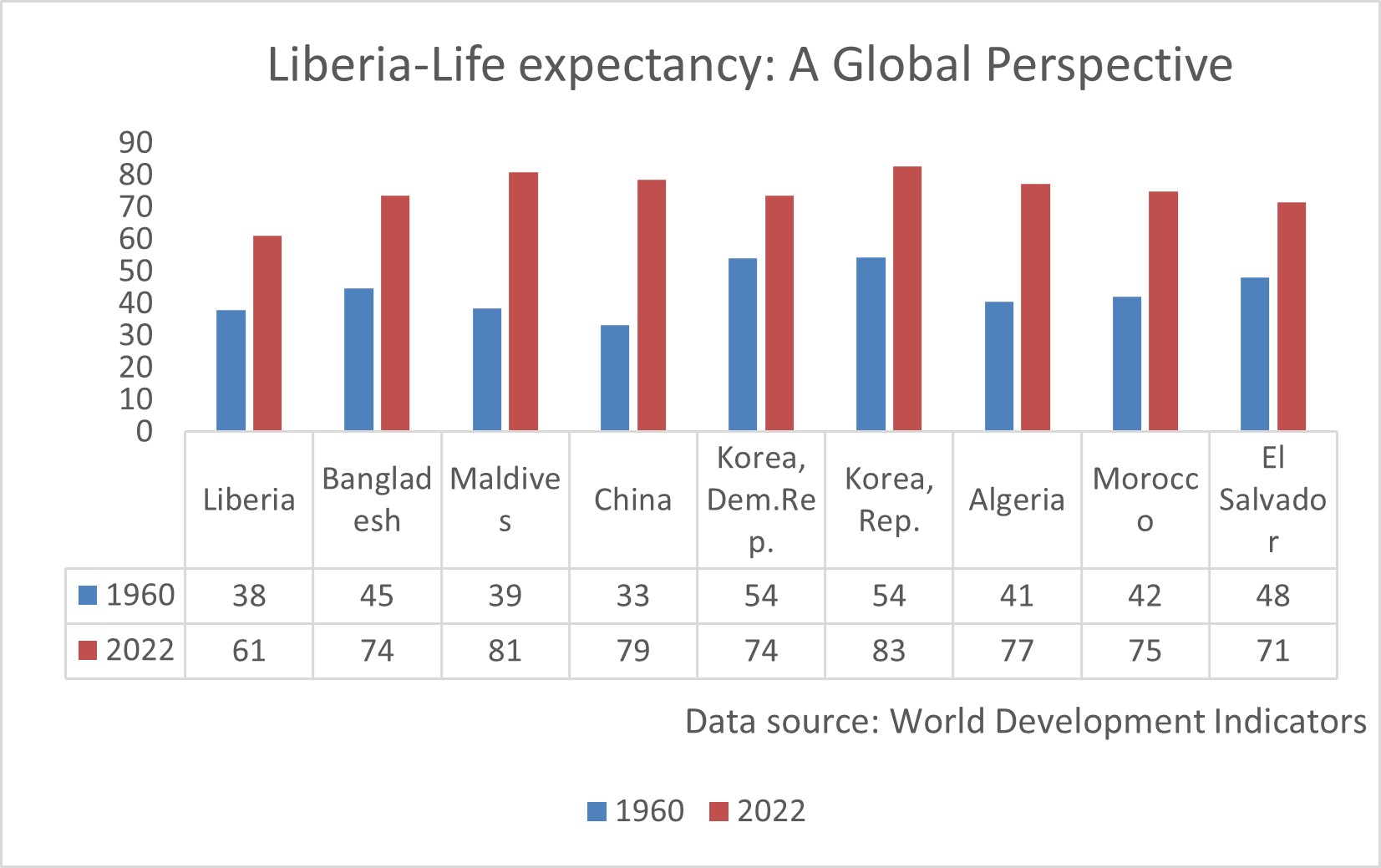
Liberia-Mortality rate, under-5 (per 1000 live births): A Global Perspective
Since 1950, global child mortality rates have significantly declined due to improvements in living conditions, healthcare access, nutrition, and safe drinking water. In regions like Europe and North America, rates have fallen below four percent, demonstrating the benefits of strong healthcare systems and economic stability. While many developing countries in South America, Asia, and Africa have made progress, Sub-Saharan Africa still faces slow advancements. Liberia’s under-five mortality rate decreased from 244 in 1980 to 73 in 2022. In contrast, Bangladesh reduced child mortality from 206 in 1980 to 29 in 2022, and India achieved a drop from 169 to 29 in the same period. These figures highlight ongoing challenges due to weak healthcare systems and the urgent need for governance reforms in Sub-Saharan Africa to effectively reduce child mortality and improve health outcomes.
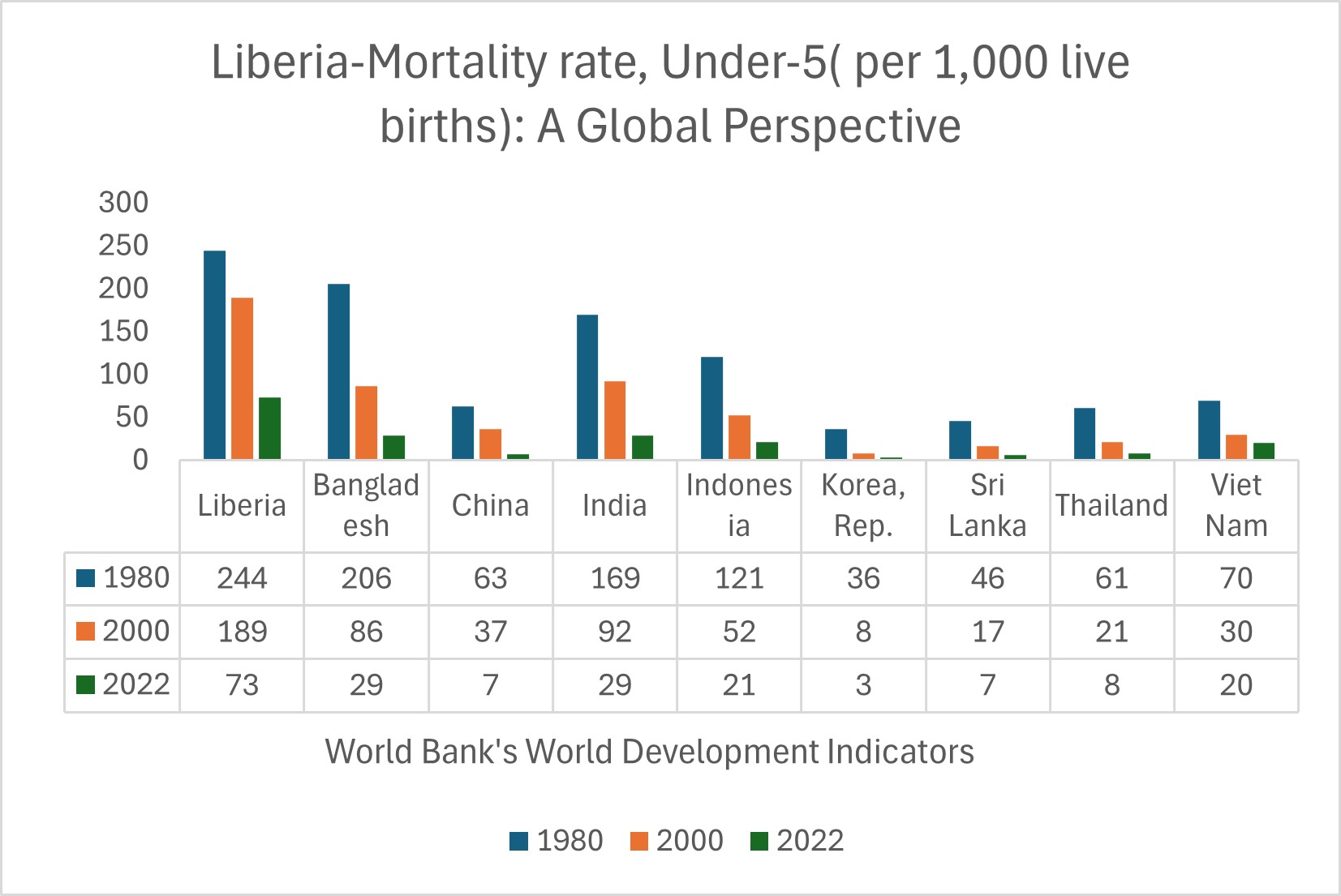
Liberia-Maternal mortality ratio (per 100,000 live births): A Global Perspective
Liberia has seen its maternal mortality ratio decline from 777 in 2000 to 652 in 2020, but this figure remains critically high, underscoring the significant challenges mothers face. Despite this progress, maternal mortality rates in Liberia are starkly higher than those in Bangladesh, India, and Vietnam, which reported 123, 103, and 46 respectively in 2022. This alarming contrast emphasizes the troubling number of pregnancy-related deaths in Liberia, worsened by a high birth rate and persistently elevated maternal mortality figures. These statistics reveal serious deficiencies in the healthcare system and ongoing underfunding impacting healthcare infrastructure across Sub-Saharan Africa, highlighting the urgent need for substantial improvements to ensure the safety and well-being of mothers and children in Liberia.
